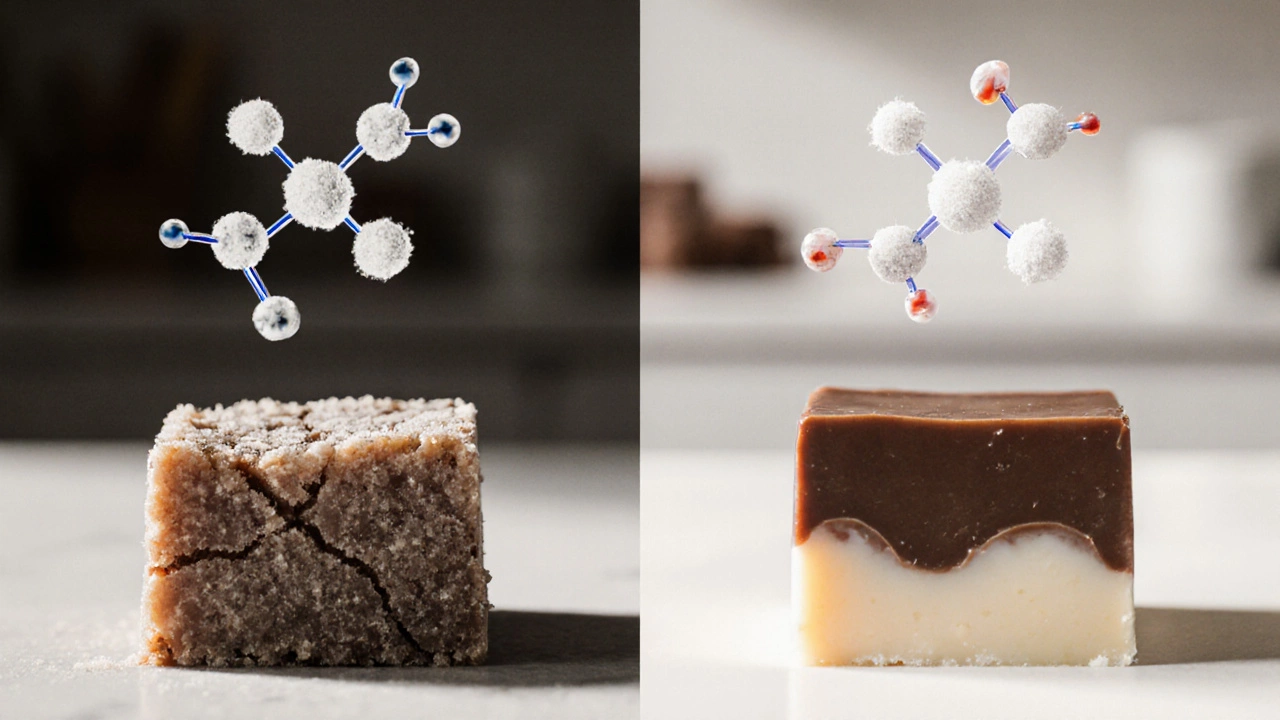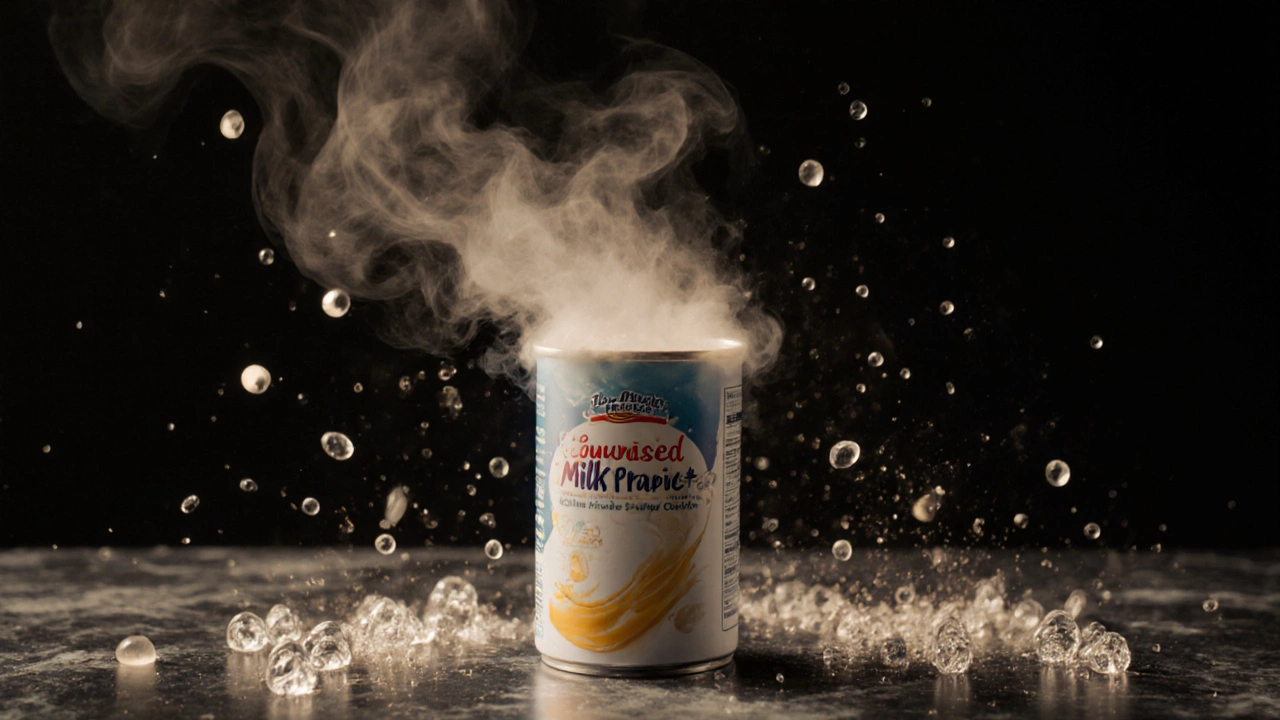Milk Water Content Calculator
Why This Matters
Regular milk (87% water) requires extra cooking time to remove excess moisture, increasing risk of sugar crystallization. Evaporated milk (35% water) reduces cooking time by 10-15 minutes and creates smaller sugar crystals for creamier texture.
Using evaporated milk reduces water content by 52% - that's why it sets faster and creates smoother fudge. Result: Your fudge will be creamier, more stable, and require less cooking time.
Ever made fudge that turned out grainy, too soft, or just plain dull? You followed the recipe, measured everything perfectly, but something still felt off. The problem might not be your stove or your patience-it could be the milk you used. If your fudge recipe calls for evaporated milk, don’t skip it thinking it’s just a fancy substitute. There’s a real, measurable reason it’s there. And it’s not about flavor alone.
What Makes Fudge Work?
Fudge isn’t just sweetened chocolate. It’s a precise sugar crystal structure held together by fat and moisture. The magic happens when sugar dissolves completely, then cools slowly into tiny, uniform crystals. Too big? Crunchy, not smooth. Too few? Runny, not set. Too much moisture? It won’t firm up. That’s where evaporated milk steps in.
Regular milk is about 87% water. When you boil it in a fudge recipe, that water evaporates-but not evenly, and not fast enough. You end up with a longer cooking time, uneven heating, and a higher chance of sugar crystallizing in big, unpleasant clumps. Evaporated milk? It’s already had over half its water removed-about 60%. That means less water to boil off during cooking, which gives you more control.
Why Evaporated Milk Over Condensed Milk?
People often confuse evaporated milk with sweetened condensed milk. They look similar-both come in cans, both are thick-but they’re not interchangeable. Sweetened condensed milk has sugar added (about 40% by weight). That’s fine for some desserts, but for classic fudge, it’s too sweet. You’d need to cut back on granulated sugar, and even then, the texture suffers.
Evaporated milk is unsweetened. That means you keep full control over sweetness. You add the exact amount of sugar your recipe calls for. The result? A balanced flavor that lets the chocolate or other flavors shine. Plus, the proteins and fats in evaporated milk are concentrated, which helps bind the sugar crystals into a smooth, glossy finish.
The Science of Fat and Protein
Evaporated milk isn’t just water with less volume. It’s a concentrated source of milk solids-proteins, fats, and lactose. These play a quiet but critical role in fudge texture.
The proteins in milk, especially casein, act like tiny anchors. They surround sugar crystals as they form, preventing them from sticking together into large clumps. The fat coats the crystals too, making them feel smoother on your tongue. That’s why fudge made with evaporated milk feels velvety, not chalky.
Studies from the University of Wisconsin’s Food Science Department show that fudge made with evaporated milk has a 22% smaller average crystal size compared to fudge made with regular milk. Smaller crystals = creamier mouthfeel. That’s not opinion. That’s measurable.
What Happens If You Use Regular Milk?
You can use regular milk. But you’ll need to cook it longer-sometimes 10 to 15 extra minutes-to drive off the excess water. That increases the risk of burning the bottom of the pan, especially if you’re not stirring constantly. Longer cooking also means the sugar spends more time at high heat, which can cause caramelization or even scorching.
One home baker in Perth tried making fudge with whole milk and ended up with a sticky, chewy mess that never set. She thought she’d just forgotten to boil it long enough. She tried again, cooking it to 238°F (the soft-ball stage), but still got the same result. Only when she switched to evaporated milk did it set perfectly in 12 minutes. Her mistake? Not realizing that the water content was the problem, not the temperature.

What About Coconut Milk or Other Alternatives?
If you’re dairy-free, you might wonder if canned coconut milk works. The short answer: not really. Full-fat coconut milk has fat and water, but it lacks the milk proteins that help control sugar crystallization. Fudge made with coconut milk tends to be greasy, doesn’t hold shape well, and can separate as it cools.
Some people try oat milk or almond milk. Those are even worse-they’re mostly water and thickeners. They don’t have the protein structure needed. You might get a sweet paste, but it won’t slice like fudge. If you need a dairy-free option, look for recipes specifically designed for coconut cream and added stabilizers like agar-agar. Don’t just swap evaporated milk for plant milk.
Does the Brand Matter?
Not really. Most canned evaporated milk brands-whether it’s Carnation, Great Value, or a local supermarket brand-are made the same way: milk is heated under vacuum to remove water, then homogenized and sterilized. The fat content is standardized at around 7-8%. That’s what you need.
Just avoid anything labeled “evaporated milk blend” or “light evaporated milk.” Those often have added water or stabilizers that can interfere with texture. Stick to the plain, full-fat version. Check the ingredient list: it should say only “milk.” No additives. No preservatives. Just milk.
Pro Tip: Don’t Stir After Boiling
Once your fudge mixture reaches the soft-ball stage (234-238°F), stop stirring. Stirring while cooling encourages big sugar crystals to form. Let it cool to 110°F undisturbed, then beat it by hand or with a mixer until it loses its gloss and thickens. That’s when the magic happens-the tiny crystals form evenly, and the texture turns creamy.
Using evaporated milk makes this step easier because the mixture cools faster and more evenly. Less time waiting, less chance of messing it up.

Real Fudge, Real Results
Try this: Make two batches of fudge. One with evaporated milk. One with whole milk. Use the exact same recipe, same pan, same heat setting. Taste them side by side. The evaporated milk batch will be firmer, smoother, and have a richer chocolate flavor. The milk batch will be softer, maybe slightly grainy, and might stick to the wrapper.
That’s not magic. That’s chemistry. Evaporated milk gives you control over moisture, consistency, and texture. It’s not a shortcut. It’s a tool. And in fudge making, where precision matters more than in most desserts, tools like this make all the difference.
Why This Matters Beyond Fudge
This isn’t just about fudge. The same principle applies to caramel, marshmallows, and even some types of truffles. Controlling water content is key to texture in sugar-based confections. Once you understand why evaporated milk works, you start seeing it in other recipes-not as a random ingredient, but as a deliberate choice by experienced bakers.
Next time you see evaporated milk in a dessert recipe, don’t think, “Why not just use regular milk?” Think, “They’re trying to control moisture. They know what they’re doing.”
Can I use evaporated milk instead of heavy cream in fudge?
Yes, but not directly. Evaporated milk has less fat than heavy cream (7-8% vs. 36-40%). If you swap it in, your fudge will be less rich and may not set as firmly. To compensate, add 1-2 tablespoons of butter per cup of evaporated milk. This adds back the fat needed for creaminess without changing the water balance.
Does evaporated milk make fudge sweeter?
No. Evaporated milk is unsweetened. It’s just concentrated milk. The sweetness in fudge comes from the granulated sugar you add. That’s why it’s preferred over sweetened condensed milk-because you control the sugar level exactly.
Why does my fudge turn out crumbly even with evaporated milk?
Crumbly fudge usually means the sugar crystals got too big. That happens when you stir the mixture after it’s been boiled, or if you cool it too fast. Make sure you stop stirring once it reaches 238°F. Let it cool undisturbed to 110°F before beating. Also, check your candy thermometer-it might be off by a few degrees.
Can I use evaporated milk in microwave fudge?
Yes. Microwave fudge recipes often use evaporated milk because it reduces cooking time and prevents overheating. Just make sure you heat the mixture in 30-second bursts, stirring between each, until the sugar fully dissolves. Then let it sit for 2 minutes before adding chocolate and stirring. The lower water content helps it set faster and smoother.
Is evaporated milk the same as dulce de leche?
No. Dulce de leche is milk that’s been slowly cooked with sugar until it caramelizes. It’s sweet, thick, and has a deep brown color. Evaporated milk is unsweetened, pale, and only reduced in water. They’re not interchangeable. Using dulce de leche in fudge will make it too sweet and change the texture completely.
Final Thought: It’s Not a Trick-It’s a Technique
Evaporated milk isn’t a gimmick. It’s not there to make your fudge look fancy on Instagram. It’s there because it works. It gives you a smoother texture, faster cooking, and more reliable results. If you’ve been struggling with fudge that won’t set or tastes grainy, switching to evaporated milk might be the single best change you make.
Don’t overthink it. Grab a can. Follow the recipe. Let the science do the work. Your fudge will thank you.